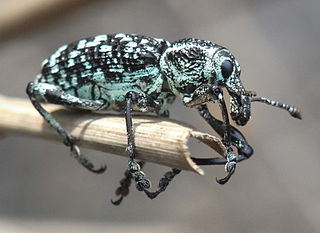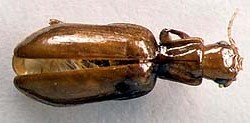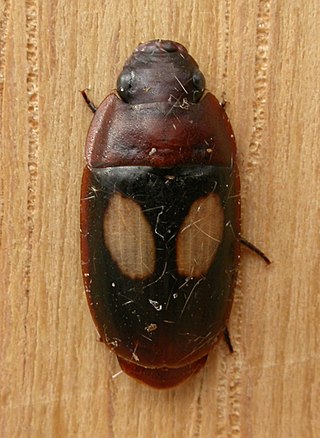
Chrysolopus spectabilis is a species of weevil found in south-eastern Australia. It was discovered during James Cook's first voyage, and became one of the first insects to be described from Australia. The weevil measures up to 25 mm (1.0 in) long and includes distinctive metallic green and black scales. It is found only on 28 species of the plant genus Acacia.
Pheropsophus aequinoctialis is a species of ground beetle from Central and South America that feeds as larvae on the eggs of mole crickets but as an adult is a generalist feeder.
Taphroceroides is a genus of beetles in the family Buprestidae, the jewel beetles. The genus was erected in 2008 for T. mimeticus, a new species from Costa Rica. Two other species have since been described from French Guiana.

Guatemalteca is a genus of beetle in the family Carabidae. As of 2017, its only described species is its type species, Guatemalteca virgen. When Terry Erwin named the genus in 2004, he placed it in the tribe Lachnophorini; in 2014 he and Laura S. Zamorano placed it in the subtribe Eucaerina.

Nototylinae is a subfamily of beetles in the family Carabidae. It contains the single genus Nototylus with two species, Nototylus fryi and Nototylus balli which was described in 2020. The first described species N. fryi was represented by a single specimen from Espiritu Santo where the forests were converted for plantations of sugarcane or cacao, and for cattle rearing. The species is considered likely extinct, although some specimens are possibly still live in protected areas like Sooretama Biological Reserve.

Pseudomorphinae is a subfamily of ground beetles in the family Carabidae. There are about 12 genera and at least 360 described species in Pseudomorphinae.
Halocoryza is a genus of beetles in the family Carabidae, containing the following species:

Tasmanitachoides is a genus of ground beetles in the family Carabidae, endemic to Australia. The beetles are very small, typically 1.5 to 3.0 mm. in length, and live in coarse sand or fine gravel along freshwater shorelines throughout Australia.

Ross Taylor Bell was an American entomologist with particular interest in the invertebrate natural history of Vermont, United States, and carabid beetles. Together with his wife, Joyce Rockenbach Bell, his work at the University of Vermont was largely taxonomic, where they described more than 75% of the rhysodine species known to science. Ross also wrote a number of seminal papers in his chosen field.

Proseicela is a genus of leaf beetles.
Bembidion salebratum is a species of beetle in the family Carabidae. It is found in Canada and the United States.
Thoasia is a genus of beetle in the family Carabidae. It was once classified as a monotypic genus with the species Thoasia rugifrons, however recently three new species was found.
Lebia histrionica is a species of beetle in the family Carabidae. The species is known from U.S. state of Arizona as well as Mexico and Guatemala.
Rhadine caudata is a species of beetle native to the eastern United States. It is a brachypterous habitat specialist, occurring in only two of five forest classes in a North Carolina study. R. caudata is a considered a Vulnerable species at the global level on NatureServe, Imperiled in Alabama, and Vulnerable in Virginia.

Antarctotrechus balli is extinct species of ground beetle known from the Miocene of Antarctica, the only species of the genus Antarctotrechus. It belongs to the tribe Trechini, and appears to be closely related to South American and Australian trechines. It was less than a centimeter long, with dark brown elytra, which are the only known parts of the animal. It is thought to have lived in a tundra environment, which included Nothofagus prostrate shrubs, Ranunculus (buttercups) and moss that grew around the banks of a stream on the outwash plain at the head of a fjord.

Sultana sultana is a species from the genus Sultana.
Beulah Garner FRES is an entomologist in the United Kingdom. She is Senior Curator at the Natural History Museum, London and is an expert of beetles, in particular the ground beetles (Carabidae).

Pheropsophus is a type of ground beetle, which is commonly known as the Bombardier beetle. There are hundreds of species of this beetle, including the genera Pheropsophus and Brachinus. They have mostly dark or black body types, but they might have some orange or yellow spots on the abdomen or thorax. Their legs are always yellow, with dark spots on the knees. They have long, distinct antennae that match the color of their legs. They can grow up to a length of 1 inch in size.










